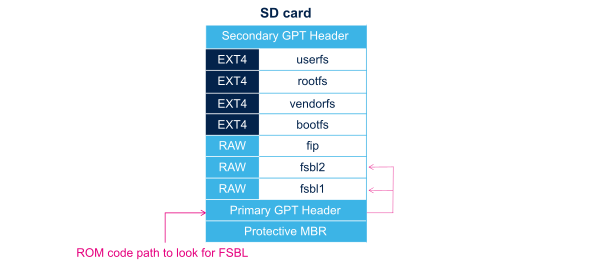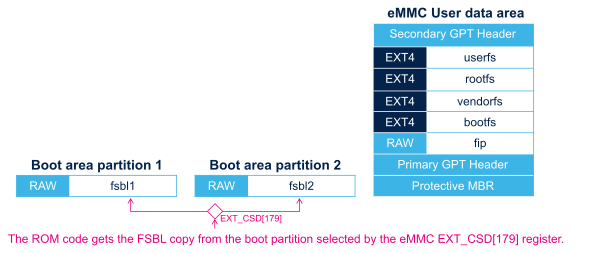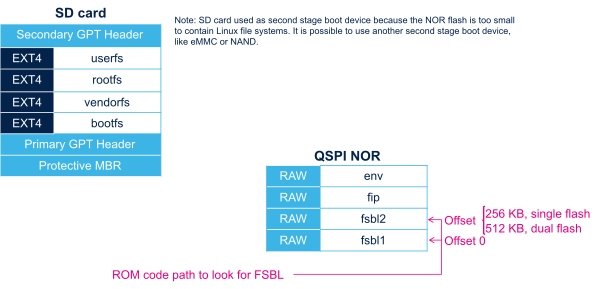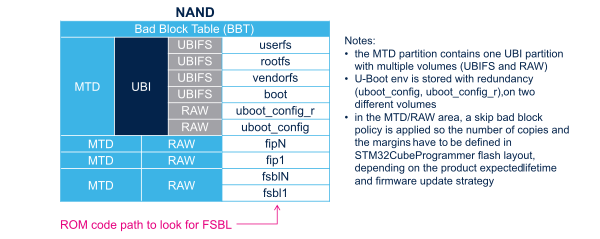Registered User |
Registered User |
||
| (28 intermediate revisions by 5 users not shown) | |||
| Line 1: | Line 1: | ||
__FORCETOC__ | __FORCETOC__ | ||
== Supported Flash memory technologies == | == Supported Flash memory technologies == | ||
STM32MP15 boards support the following types of Flash memory: | |||
* SD card on SDMMC interface | * SD card on the SDMMC interface present on [[:Category:Getting started with STM32MP1 boards|EVAL and DISCO boards]] | ||
* ''e''•MMC on SDMMC interface | * ''e''•MMC on the SDMMC interface present on [[:Category:Getting started with STM32MP1 boards|EVAL board]] only | ||
* Serial NOR Flash on Dual QSPI interface | * Serial NOR Flash memory on the Dual QSPI interface present on [[:Category:Getting started with STM32MP1 boards|EVAL board]] only | ||
* NAND Flash on FMC interface | * NAND Flash memory on the FMC interface present on [[:Category:Getting started with STM32MP1 boards|EVAL board]] only. | ||
The next section lists all partitions used on STM32MP15 boards (size, name, content) and the following sections | The next section lists all partitions used on STM32MP15 boards (size, name, and content), and the following sections show how they are mapped on the different types of Flash memory. | ||
== Flash partitions == | == Flash partitions == | ||
The tables below list the partitions defined for STMP32MP15 boards. | The tables below list the partitions defined for STMP32MP15 boards. | ||
<br> | |||
{| class="st-table" | {| class="st-table" | ||
|- | |- | ||
| Line 17: | Line 18: | ||
| Remaining area || userfs || The user file system contains user data and examples | | Remaining area || userfs || The user file system contains user data and examples | ||
|- | |- | ||
| 768 | | 768 Mbytes || rootfs || Linux root file system contains all user space binaries (executable, libraries, and so on), and kernel modules | ||
|- | |- | ||
| 16 | | 16 Mbytes || vendorfs || This partition is preferred to the rootfs for third-party proprietary binaries, and ensures that they are not contaminated by any open source licence, such as GPL v3 | ||
|- | |- | ||
| 64 | | 64 Mbytes || bootfs<br>or<br>boot (NAND)|| The boot file system contains: | ||
* (option) the init | * (option) the init RAM file system, which can be copied to the external RAM and used by Linux before mounting a fatter rootfs | ||
* Linux kernel device tree (can be in a Flattened Image Tree - FIT) | * Linux kernel device tree (can be in a Flattened Image Tree - FIT) | ||
* Linux kernel U-Boot image (can be in a Flattened Image Tree - FIT) | * Linux kernel U-Boot image (can be in a Flattened Image Tree - FIT) | ||
* For all flashes | * For all flashes except for NOR: the boot loader splash screen image, displayed by U-Boot | ||
* U-Boot distro config file | * [[U-Boot_overview#Generic_Distro_configuration|U-Boot distro config file]] ''extlinux.conf'' | ||
|- | |- | ||
| 256 | | 2 * 256 Kbytes (*) || env<br>or uboot_config / uboot_config_r (NAND) || This partition is used to store the U-Boot environment while booting from NOR Flash. The information is stored twice, for redundancy. <br> | ||
For all other Flash devices, the U-Boot environment is stored either in an EXT4 bootfs partition (''e''•MMC, SD card), or UBI volumes (NAND). | |||
|- | |- | ||
| | | 4 Mbytes || fip || The [[TF-A_overview#FIP|TF-A firmware image package (FIP)]] is a binary file that encapsulates several binaries, and their certificates (optionally, for authentication), that will be loaded by TF-A]].<br> | ||
OpenSTLinux FIP contains: | |||
* the second stage boot loader (SSBL): | |||
** U-Boot binary | |||
** U-Boot device tree blob | |||
* optionally, the OP-TEE binaries: | |||
** OP-TEE header | |||
** OP-TEE pageable code and data | |||
** OP-TEE pager | |||
|- | |- | ||
| 256 | | 256 Kbytes to 512 Kbytes (*) || fsbl || The first stage boot loader is Arm Trusted Firmware ([[TF-A_overview#BL2|TF-A]]). At least two copies are embedded.<br> | ||
Note: due to ROM code RAM needs, the FSBL payload is limited to 247 Kbytes. | |||
|} | |} | ||
(*): | (*): The partition size depends on the Flash technology, to be aligned to the block erase size of the Flash memory present on the board: NOR (256 Kbytes) / NAND (512 Kbytes). | ||
{{Info | Some boards can be equipped with multiple Flash devices, like the [[:Category:Getting started with STM32MP1 boards|EVAL board]], where all of the Flash devices can be programmed with [[STM32CubeProgrammer]]. However, caution must be taken for the serial NOR/NAND and SLC NAND because a '''static bootable MTD partitioning''' is defined in U-Boot default config (see [[How_to_configure_U-Boot_for_your_board#MTD_partitions|MTD configuration ]] for details), with the consequence that up to 6 Mbytes of space is lost at the beginning of each such device, '''even those which are not bootable'''.}} | |||
== SD card memory mapping == | == SD card memory mapping == | ||
The SD card has to be partitioned with GPT format to be recognized by STM32MP15. The easiest way to achieve this is to use [[STM32CubeProgrammer]].<br /> | The SD card has to be partitioned with GPT format in order to be recognized by the STM32MP15. The easiest way to achieve this is to use [[STM32CubeProgrammer]].<br /> | ||
The ROM code looks for the GPT entries whose | The ROM code looks for the GPT entries whose name begins with "fsbl": fsbl1 and fsbl2 for example.<br/> | ||
Note: | Note: The SD card can be unplugged from the board and inserted into a Linux host computer for direct partitioning with Linux utilities and access to the '''bootfs''', '''rootfs''' and '''userfs''' partitions. The file system is Linux EXT4. | ||
[[Image:SD card mapping.png|center|link=]] | [[Image:SD card mapping.png|center|link=]] | ||
== ''e''•MMC memory mapping == | == ''e''•MMC memory mapping == | ||
The ''e''•MMC embeds four physical partitions: | The ''e''•MMC embeds four physical partitions: | ||
* Boot area partition 1: one copy of the FSBL | * Boot area partition 1: one copy of the FSBL | ||
* Boot area partition 2: one copy of the FSBL | * Boot area partition 2: one copy of the FSBL | ||
* User data area: formatted with GPT partitioning and used to store all remaining partitions | * User data area: formatted with GPT partitioning and used to store all remaining partitions | ||
* Replay Protected Memory Block (RPMB): not shown in the figure below, since not involved in the current boot chain. | * Replay Protected Memory Block (RPMB): not shown in the figure below, since not involved in the current boot chain. | ||
[[STM32CubeProgrammer]] has to be used to prepare the ''e''•MMC with the layout shown below and to populate each partition. | [[STM32CubeProgrammer]] has to be used to prepare the ''e''•MMC with the layout shown below, and to populate each partition. | ||
{{Info | The boot area partition used by the ''e''•MMC boot sequence is selected via the EXT_CSD[179] register | {{Info | The boot area partition used by the ''e''•MMC boot sequence is selected via the EXT_CSD[179] register in the ''e''•MMC. The [[STM32CubeProgrammer]] execution is concluded with the selection of the last written partition from the flashlayout file, typically partition 2. The other copy is never used as long as the user does not explicitly change the ''e''•MMC EXT_CSD[179] register to select it.}} | ||
[[File:eMMC mapping.png|center|link=]] | [[File:eMMC mapping.png|center|link=]] | ||
== NOR memory mapping == | == NOR memory mapping == | ||
NOR Flash | As NOR Flash memory is expensive, its size is usually limited to the minimum needed to store only the bootloaders. The system files (bootfs, rootfs and userfs) are usually stored in another Flash memory, such as the SD card in OpenSTLinux distribution.<br /> [[STM32CubeProgrammer]] must be used to prepare the NOR Flash and the SD card with the layout shown below, and to populate each partition.<br /><br> | ||
It is possible to use an ''e''•MMC card or NAND | It is possible to use an ''e''•MMC card or NAND as second-level Flash memory, rather than an SD card. This requires the following aspects to be changed: | ||
* | * The Flash memory layout, using [[STM32CubeProgrammer]] in order to write the rootfs and userfs to the targeted Flash memory | ||
* | * The Linux kernel parameters, using [[U-Boot overview|U-Boot]], in order to indicate where the rootfs and userfs have to be mounted. | ||
[[File:NOR mapping.png|center|link=]] | [[File:NOR mapping.png|center|link=]] | ||
== NAND memory mapping == | == NAND memory mapping == | ||
[[STM32CubeProgrammer]] has to be used to prepare the NAND Flash with the layout shown below, and to populate each partition.<br /> | [[STM32CubeProgrammer]] has to be used to prepare the NAND Flash memory with the layout shown below, and to populate each partition.<br /> | ||
[[File:NAND mapping.png|center|link=]] | [[File:NAND mapping.png|center|link=]] | ||
{{Warning|In the '''RAW/MTD area''', the number of copies to embed and the number of blocks to reserve at the end of each partition, for future bad blocks replacement, are a critical part of NAND based product dimensioning !<br> | |||
The strategy has to take into account many parameters such as: | |||
* the binaries sizes, | |||
* the read accesses to those partitions during product life, that may generate read disturb effect, | |||
* the capability of the product to refresh the partitions content when erroneous bits are detected, | |||
* the number of software updates estimated on this partition, | |||
* the selected NAND flash characteristics | |||
ST set foundations in the STM32MP15 device in order to allow the integration of NAND flash memories but the product definition remains the customer responsibility. Please, contact your memory provider for further advice.}} | |||
<noinclude> | <noinclude> | ||
[[Category:STM32MP15 platform configuration|1]] | [[Category:STM32MP15 platform configuration|1]] | ||
{{PublicationRequestId | | {{PublicationRequestId | 14615 | 2020-01-15 |}} | ||
</noinclude> | </noinclude> | ||
Latest revision as of 13:20, 26 March 2021
1. Supported Flash memory technologies
STM32MP15 boards support the following types of Flash memory:
- SD card on the SDMMC interface present on EVAL and DISCO boards
- e•MMC on the SDMMC interface present on EVAL board only
- Serial NOR Flash memory on the Dual QSPI interface present on EVAL board only
- NAND Flash memory on the FMC interface present on EVAL board only.
The next section lists all partitions used on STM32MP15 boards (size, name, and content), and the following sections show how they are mapped on the different types of Flash memory.
2. Flash partitions
The tables below list the partitions defined for STMP32MP15 boards.
| Size | Component | Comment |
|---|---|---|
| Remaining area | userfs | The user file system contains user data and examples |
| 768 Mbytes | rootfs | Linux root file system contains all user space binaries (executable, libraries, and so on), and kernel modules |
| 16 Mbytes | vendorfs | This partition is preferred to the rootfs for third-party proprietary binaries, and ensures that they are not contaminated by any open source licence, such as GPL v3 |
| 64 Mbytes | bootfs or boot (NAND) |
The boot file system contains:
|
| 2 * 256 Kbytes (*) | env or uboot_config / uboot_config_r (NAND) |
This partition is used to store the U-Boot environment while booting from NOR Flash. The information is stored twice, for redundancy. For all other Flash devices, the U-Boot environment is stored either in an EXT4 bootfs partition (e•MMC, SD card), or UBI volumes (NAND). |
| 4 Mbytes | fip | The TF-A firmware image package (FIP) is a binary file that encapsulates several binaries, and their certificates (optionally, for authentication), that will be loaded by TF-A]]. OpenSTLinux FIP contains:
|
| 256 Kbytes to 512 Kbytes (*) | fsbl | The first stage boot loader is Arm Trusted Firmware (TF-A). At least two copies are embedded. Note: due to ROM code RAM needs, the FSBL payload is limited to 247 Kbytes. |
(*): The partition size depends on the Flash technology, to be aligned to the block erase size of the Flash memory present on the board: NOR (256 Kbytes) / NAND (512 Kbytes).
3. SD card memory mapping
The SD card has to be partitioned with GPT format in order to be recognized by the STM32MP15. The easiest way to achieve this is to use STM32CubeProgrammer.
The ROM code looks for the GPT entries whose name begins with "fsbl": fsbl1 and fsbl2 for example.
Note: The SD card can be unplugged from the board and inserted into a Linux host computer for direct partitioning with Linux utilities and access to the bootfs, rootfs and userfs partitions. The file system is Linux EXT4.

4. e•MMC memory mapping
The e•MMC embeds four physical partitions:
- Boot area partition 1: one copy of the FSBL
- Boot area partition 2: one copy of the FSBL
- User data area: formatted with GPT partitioning and used to store all remaining partitions
- Replay Protected Memory Block (RPMB): not shown in the figure below, since not involved in the current boot chain.
STM32CubeProgrammer has to be used to prepare the e•MMC with the layout shown below, and to populate each partition.

5. NOR memory mapping
As NOR Flash memory is expensive, its size is usually limited to the minimum needed to store only the bootloaders. The system files (bootfs, rootfs and userfs) are usually stored in another Flash memory, such as the SD card in OpenSTLinux distribution.
STM32CubeProgrammer must be used to prepare the NOR Flash and the SD card with the layout shown below, and to populate each partition.
It is possible to use an e•MMC card or NAND as second-level Flash memory, rather than an SD card. This requires the following aspects to be changed:
- The Flash memory layout, using STM32CubeProgrammer in order to write the rootfs and userfs to the targeted Flash memory
- The Linux kernel parameters, using U-Boot, in order to indicate where the rootfs and userfs have to be mounted.

6. NAND memory mapping
STM32CubeProgrammer has to be used to prepare the NAND Flash memory with the layout shown below, and to populate each partition.
